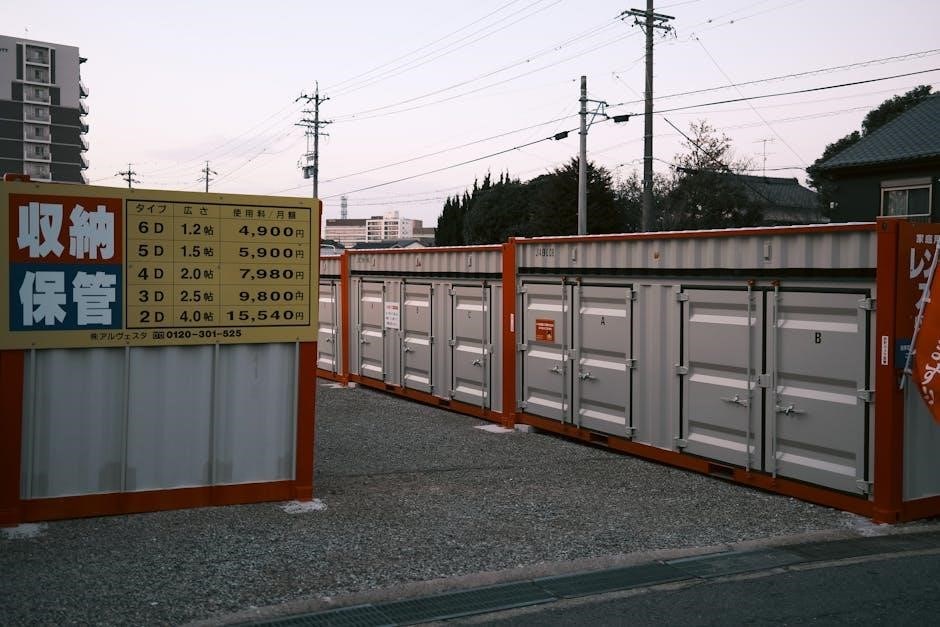public storage rental agreement pdf
A public storage rental agreement PDF is a legally binding contract outlining terms for renting storage space, ensuring clarity and protection for both lessor and lessee.
Overview of the Agreement
A public storage rental agreement PDF serves as a legally binding contract between the storage facility owner (lessor) and the renter (lessee). It outlines the terms and conditions for renting a storage unit, including the lease duration, monthly rent, access rights, and security measures. The agreement ensures both parties understand their responsibilities and rights, providing clarity on payment terms, facility rules, and potential penalties for breaches. It is customizable to accommodate various storage needs and ensures a smooth rental process for all parties involved.
Importance of a Storage Rental Agreement
A storage rental agreement is essential as it provides legal protection for both the lessor and lessee, ensuring clarity on responsibilities and expectations. It prevents disputes by outlining rent, access rights, and security measures. The agreement safeguards the lessee’s stored property and holds the lessee accountable for damages or rule violations. By formalizing terms, it protects both parties from potential conflicts, ensuring a clear understanding of obligations. This document fosters trust and ensures smooth operations, making it a critical component of any storage rental arrangement.
Benefits of Using a PDF Template
Using a PDF template for a public storage rental agreement offers numerous advantages. It ensures professionalism and clarity, providing a structured format that covers all essential terms. The template is easily customizable, allowing users to adapt it to specific needs. PDFs are widely compatible and maintain their formatting across devices, ensuring consistency. They also provide a legally binding document that protects both parties. Additionally, PDF templates save time and reduce errors, making the process efficient and straightforward. This makes them an ideal choice for creating a clear, professional, and enforceable storage rental agreement.

Key Elements of a Public Storage Rental Agreement
A public storage rental agreement includes terms like rental duration, payment details, access rights, security measures, and responsibilities, ensuring clarity and protection for both parties involved.
Parties Involved: Lessor and Lessee
The public storage rental agreement PDF identifies the lessor (storage facility owner) and lessee (renter) as primary parties. The lessor agrees to provide secure storage space, while the lessee obtains rights to use the unit for storing property. Both parties must sign the agreement, ensuring mutual understanding of responsibilities and terms. Clear identification of roles is crucial for enforcing the contract and resolving disputes. This section establishes accountability and outlines expectations for both sides, ensuring a legally binding arrangement. Proper documentation of identities and signatures is essential for validity.
Term of the Agreement and Termination Clause
The term of the agreement specifies the rental duration, often month-to-month, continuing until terminated by either party. A termination clause outlines required notice periods, typically 10-30 days, for either party to end the agreement. This ensures clarity on how and when the rental can be ended. The lessee must provide written notice before the rental due date to avoid further charges. The lessor may terminate for non-payment or breach, with specific procedures for handling abandoned property. This clause protects both parties by defining termination rights and responsibilities.
Rental Rates and Payment Terms
The agreement specifies the rental rate, payment due dates, and accepted payment methods. Rent is typically due on the first of each month, with late fees applied for overdue payments. The lessee is responsible for paying the agreed-upon rate, which may be subject to changes with proper notice. Payment methods often include cash, checks, or electronic transfers. The lessor may offer discounts for long-term rentals or impose penalties for late payments. This section ensures both parties understand their financial obligations and the consequences of non-payment.
Access Rights and Facility Hours
The agreement outlines the lessee’s access rights to the storage unit, including entry during specified hours. Lessees typically gain access using keys, codes, or gate access. Facility hours are detailed, such as 24/7 access or standard business hours. Emergency access procedures may also be included. The lessor ensures the facility remains accessible during agreed-upon times, while the lessee must adhere to these hours to avoid penalties or restrictions. This section balances convenience with security, ensuring both parties understand access limitations and responsibilities.
Security Measures and Responsibilities
The agreement details security measures, such as gated access, surveillance cameras, and on-site staff, to protect stored property. Lessees are often responsible for securing their unit with a lock and may be required to purchase insurance for high-value items. The lessor ensures the facility maintains adequate security systems, while the lessee must not store prohibited items that pose a risk. This section clarifies both parties’ roles in maintaining a safe and secure storage environment, balancing protection with accountability. Proper security protocols help prevent theft or damage to stored goods.

Insurance Requirements and Liability
The agreement outlines insurance requirements, often mandating lessees to insure stored items against loss or damage. The lessor may offer insurance options or require proof of external coverage. Liability clauses typically limit the lessor’s responsibility for damages unless caused by their negligence. Lessees are generally responsible for insuring high-value items, while the lessor ensures the facility’s security measures are maintained. This section protects both parties by clarifying liability and ensuring adequate coverage for stored property, addressing potential risks and losses effectively.
Prohibited Items and Usage Restrictions
The agreement specifies prohibited items, such as hazardous materials, flammable substances, and illegal goods, which cannot be stored in the unit. Lessees are also restricted from using the storage space for residential or business purposes. Usage restrictions may include prohibitions on storing perishables, living organisms, or items requiring specialized storage conditions. These clauses ensure compliance with safety regulations and prevent misuse of the facility. Lessees must adhere to these restrictions to maintain a safe and lawful storage environment, avoiding potential legal or financial consequences for non-compliance.
Amendments and Modifications
The public storage rental agreement PDF outlines the process for amendments and modifications, ensuring any changes are mutually agreed upon in writing. Both parties must consent to revisions, and modifications are legally binding once signed. Common amendments include rental rate adjustments or changes in storage unit size. The agreement may specify a notice period for proposed modifications to ensure both parties have time to review and agree. This ensures flexibility while maintaining the integrity of the contract, allowing for adaptations to changing circumstances without compromising legal standards.

Legal Requirements and Disclosures
A public storage rental agreement PDF must comply with local and state laws, including required disclosures about terms, conditions, and lessee rights, ensuring transparency and compliance.

Required Disclosures by the Lessor
The lessor must disclose key terms, including rental rates, payment terms, access rights, security measures, insurance requirements, and prohibited items. They must also outline termination clauses and liability. These disclosures ensure transparency, protecting both parties and preventing disputes. The agreement should be in writing, signed by both the lessor and lessee, to confirm understanding and compliance with legal standards. This ensures all obligations and responsibilities are clearly defined, providing a fair and binding contract for both parties involved in the storage rental arrangement.
Compliance with Local and State Laws
Compliance with local and state laws is crucial for a public storage rental agreement. Facilities must adhere to specific legal requirements, including licensing and zoning regulations, which vary by location. State laws often dictate tenant protections and procedures for handling abandoned property. The lessor must ensure the agreement reflects these laws, staying informed on any changes. The agreement should include clauses that address these regulations explicitly. Failure to comply can lead to legal consequences, so the agreement must outline measures to meet all legal standards, ensuring both parties operate within the law.
Signature and Witness Requirements
A public storage rental agreement must be signed by both the lessor and lessee to ensure validity. Witnesses may be required in some jurisdictions to validate the agreement. The signatures confirm that both parties agree to the terms outlined in the document. Proper authentication processes, such as notarization, may also be necessary to ensure legality. The agreement must clearly state the requirements for signatures and witnesses, ensuring compliance with legal standards. This step is crucial for enforcing the agreement in court if disputes arise.

Security and Access Control
Security and access control measures ensure the protection of stored property. These include secure gates, individual unit locks, and surveillance systems to safeguard belongings and ensure only authorized access.
Physical Security Measures at the Facility
Physical security measures at the facility are essential to protect stored property. These include secured gates, perimeter fencing, and individual unit locks. Many facilities employ surveillance cameras and alarm systems to monitor and deter unauthorized access. Some storage units also offer on-site staff or security personnel to oversee operations. These measures ensure a safe environment for tenants to store their belongings, with the rental agreement outlining the facility’s security protocols and the tenant’s responsibilities in maintaining unit security.
Access Control Systems and Monitoring
Access control systems and monitoring are critical for securing storage facilities. Many facilities use electronic gates with keycard or PIN access, ensuring only authorized individuals can enter. Surveillance cameras monitor the premises 24/7, often with recording capabilities to deter theft and vandalism. Some facilities employ on-site staff or remote monitoring services to oversee operations. These systems provide an additional layer of security, ensuring that only tenants with valid access can enter their units. The rental agreement typically outlines these measures, reassuring tenants of their belongings’ safety.
Surveillance and Alarm Systems
Surveillance and alarm systems are essential security features in public storage facilities. Most facilities employ 24/7 video surveillance, often with cameras equipped with night vision and motion detection. These systems act as a deterrent to potential intruders and provide valuable evidence in case of breaches. Alarm systems are typically triggered by unauthorized access or movement, alerting staff or security personnel. Some facilities integrate alarms with monitoring services, ensuring prompt responses to incidents. These measures enhance the overall security of the storage units and are often detailed in the rental agreement to reassure tenants of their belongings’ protection.

Termination and Breach of Agreement
Termination and breach clauses outline the consequences of violating the agreement, ensuring both parties understand their obligations and potential legal actions in case of non-compliance.
Proper Notice for Termination
The agreement specifies that either party must provide written notice to terminate the contract. Typically, a minimum of 10 days’ notice is required before the next rental due date. The lessee must deliver this notice to the lessor in person or via certified mail. Failure to provide timely notice may result in automatic renewal of the agreement. Upon termination, the lessee must vacate the unit and remove all belongings. If the unit is not emptied, the lessor may dispose of the contents as outlined in the agreement. Proper termination ensures a smooth end to the rental relationship.
Consequences of Breach by Lessee
If the lessee breaches the agreement, the lessor may terminate the contract and deny access to the storage unit. The lessee risks losing stored property if the breach involves non-payment or violation of usage terms. The lessor may dispose of the contents as outlined in the agreement. Legal action may be taken to recover unpaid rent or damages. Proper notice is typically required before such actions, ensuring compliance with legal standards. Breaches can result in financial penalties and loss of stored items, emphasizing the importance of adhering to the agreement’s terms.
Abandonment of Property Clause
The abandonment clause outlines procedures if the lessee abandons their stored property. If the lessee fails to pay rent or communicate, the lessor may deem the unit abandoned. Proper notice is typically sent, and if unclaimed, the lessor can dispose of or sell the contents. Proceeds from sales may cover unpaid rent or fees. This clause ensures the lessor can manage unoccupied units legally and fairly, balancing their rights with the lessee’s obligations to maintain the agreement’s terms and avoid property abandonment. Legal compliance is crucial in such cases.

How to Create a Public Storage Rental Agreement PDF
Use a template, customize terms, and ensure legal compliance. Include rental rates, access rights, and security measures. Finalize by filling in details and obtaining signatures.
Steps to Draft the Agreement
To draft a public storage rental agreement, start by selecting a suitable PDF template. Define the parties involved, including the lessor and lessee details. Outline the rental term, payment terms, and access rights. Include security measures, insurance requirements, and prohibited items. Ensure compliance with local laws and add necessary clauses like termination and amendments. Review the document for clarity and accuracy, then have both parties sign and date it. Finally, distribute copies to all involved for legal validation.
Benefits of Using a Template
Using a public storage rental agreement PDF template offers numerous advantages. It saves time by providing a pre-drafted structure, reducing legal risks with standardized language. Templates ensure consistency and clarity, covering essential clauses like payment terms, access rights, and termination. They are easily customizable to meet specific needs and comply with local laws. Additionally, templates streamline the rental process, minimizing errors and ensuring both parties understand their obligations. This makes the agreement process efficient and professional, suitable for both landlords and tenants.
Filling Out the PDF Template
Filling out a public storage rental agreement PDF template is straightforward. Start by entering the unit number, rental rates, and payment terms. Include the lessee’s personal details, such as name and contact information. Specify the rental duration, access hours, and any restrictions on stored items. Ensure all clauses, like security measures and insurance requirements, are clearly stated. Review the document for accuracy and compliance with local laws. Finally, include signature and date fields for both parties, ensuring the agreement is legally binding and properly executed.

Important Clauses to Include
Essential clauses include lease duration, payment terms, access rights, insurance requirements, prohibited items, security measures, and breach consequences to protect both parties and ensure a smooth rental process.
Force Majeure Clause
The Force Majeure Clause protects both parties from unforeseen events like natural disasters, pandemics, or wars. It excuses non-performance of obligations without liability, ensuring fairness and maintaining the relationship. This clause is essential for addressing unavoidable circumstances that may prevent either party from fulfilling their duties under the agreement. By including it, the contract remains balanced, offering relief during uncontrollable events while preserving the integrity of the rental terms. It ensures neither party is penalized for circumstances beyond their control.
Dispute Resolution Clause
A Dispute Resolution Clause outlines how conflicts between the lessor and lessee will be addressed. It often requires mediation or arbitration before legal action, ensuring issues are resolved efficiently. This clause promotes fairness and transparency, specifying procedures for resolving disagreements. By agreeing to alternate dispute resolution methods, both parties avoid costly litigation and maintain a positive relationship. The clause ensures that any disputes are handled constructively, protecting the interests of both the landlord and tenant while upholding the agreement’s terms.
Governing Law Clause
The Governing Law Clause specifies which state’s laws govern the agreement, ensuring both parties understand the applicable jurisdiction. This prevents potential disputes over which laws to apply. By aligning the agreement with specific state regulations, it ensures compliance and simplifies legal matters. This clarity is essential for maintaining a clear understanding of legal obligations and rights under the rental agreement. It also ensures that the contract is interpreted and enforced consistently, avoiding ambiguity and potential legal challenges.
Best Practices for Tenants and Landlords
Communicate clearly, inspect units, and document conditions. Tenants should review agreements thoroughly, while landlords ensure transparency in terms and maintain open dialogue for a smooth relationship.
Understanding Tenant Rights
Tenants have the right to access their stored property during facility hours and should be protected from unfair eviction or rent increases. The agreement must clarify responsibilities, ensuring tenants understand their obligations, such as maintaining insurance for stored items. Tenants should also be aware of their right to terminate the agreement with proper notice, as outlined in the contract. Understanding these rights ensures a fair and transparent rental experience, fostering a positive relationship between tenants and landlords.
Landlord Responsibilities
Landlords are responsible for maintaining a secure and clean facility, ensuring access during specified hours, and fulfilling all terms outlined in the rental agreement. They must provide a safe environment, disclose all fees, and comply with local laws. Landlords should also handle disputes fairly and maintain accurate records of payments and communications. Ensuring the facility is well-maintained and addressing tenant concerns promptly are key to upholding their responsibilities and fostering trust with tenants.
Maintaining a Positive Landlord-Tenant Relationship
Maintaining a positive landlord-tenant relationship is crucial for a smooth rental experience. Clear communication, transparency, and mutual respect are key. Landlords should respond promptly to tenant concerns and ensure the facility meets agreed standards. Tenants should uphold their responsibilities, such as paying rent on time and adhering to facility rules. Regular updates and fair dispute resolution can foster trust. Encouraging open dialogue and addressing issues proactively helps build a positive and long-lasting relationship between both parties, ensuring satisfaction and compliance with the agreement.

State-Specific Considerations
State-specific considerations ensure compliance with local laws and regulations, as storage rental agreements vary by jurisdiction. Understanding these variations is essential for legal compliance and avoiding disputes.
Variations in State Laws
Public storage rental agreements must comply with state-specific laws, which vary significantly. Some states require specific disclosures, while others have unique rules for lien enforcement or late payments. For instance, certain jurisdictions mandate a minimum notice period before auctioning abandoned property, while others have stricter requirements for insurance coverage. Understanding these variations is crucial to ensure compliance and avoid legal disputes. It is essential to tailor agreements to meet local regulations, ensuring all legal standards are upheld. Legal consultation is recommended to address state-specific nuances effectively.
Local Regulations and Compliance
Local regulations play a critical role in shaping public storage rental agreements. Municipal codes often dictate zoning laws, fire safety standards, and access requirements. Compliance with these regulations ensures operational smoothness and avoids legal penalties. For instance, some jurisdictions require specific security measures or signage. Additionally, local health and safety codes may influence facility maintenance. Understanding these regulations is essential for drafting agreements that meet all legal and operational standards. Proper compliance not only protects the business but also ensures a safe and secure environment for tenants. Regular reviews of local laws are advisable to stay updated.
A public storage rental agreement PDF is an essential legal document ensuring clarity and protection for both parties, outlining terms, responsibilities, and compliance with local laws effectively.
Final Thoughts on the Agreement
A public storage rental agreement PDF serves as a comprehensive legal framework, safeguarding both tenants and landlords by clearly defining terms, rights, and obligations. It ensures transparency, reducing disputes and fostering a harmonious relationship. Regular reviews and updates to the agreement are crucial to adapt to changing laws and needs. By using a PDF template, parties can efficiently create, share, and execute the contract, ensuring all details are accurately captured. This streamlined process promotes accountability and mutual understanding, making it an indispensable tool for modern storage rentals.
Next Steps After Signing
After signing the public storage rental agreement PDF, both parties should retain copies for their records. Tenants should review facility access details and security protocols, while landlords ensure all units are ready for occupancy. Implementing access control systems and surveillance is essential for facility security. Both parties should communicate any concerns promptly to maintain a smooth relationship. Finally, ensure all legal and insurance requirements are met to avoid future disputes, fostering a secure and organized storage experience for all involved.
Additional Resources
Explore downloadable templates, legal guides, and storage facility policies online to support your rental agreement needs, ensuring compliance and clarity in all storage transactions.
Where to Find Public Storage Rental Agreement Templates
Public storage rental agreement templates are readily available from trusted sources like legal websites, storage facility websites, and document platforms. Websites such as tarltonstorage.com and publicstorage.com offer downloadable templates tailored for storage rentals. Additionally, legal platforms like LegalZoom and LawDepot provide customizable templates designed to meet specific state laws. These resources ensure you can easily draft a professional and legally binding agreement, saving time and reducing potential errors. Templates are often available in PDF and DOC formats for convenience.
Consulting a Legal Professional
Consulting a legal professional is crucial to ensure your public storage rental agreement complies with local and state laws. They can review the document to verify all terms, including rental rates, security measures, and termination clauses, are legally binding. Legal experts can also help customize the agreement to address specific needs or unique circumstances. This ensures both parties are protected and reduces the risk of disputes. For complex situations or high-value stored items, professional legal advice is highly recommended to safeguard your interests and avoid potential legal issues down the line.
